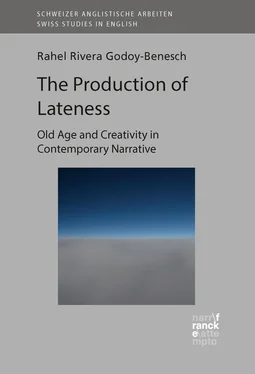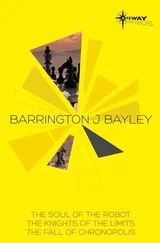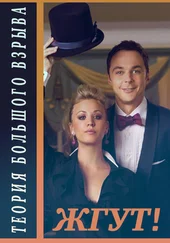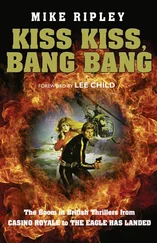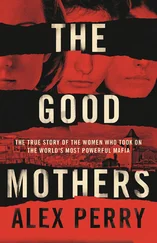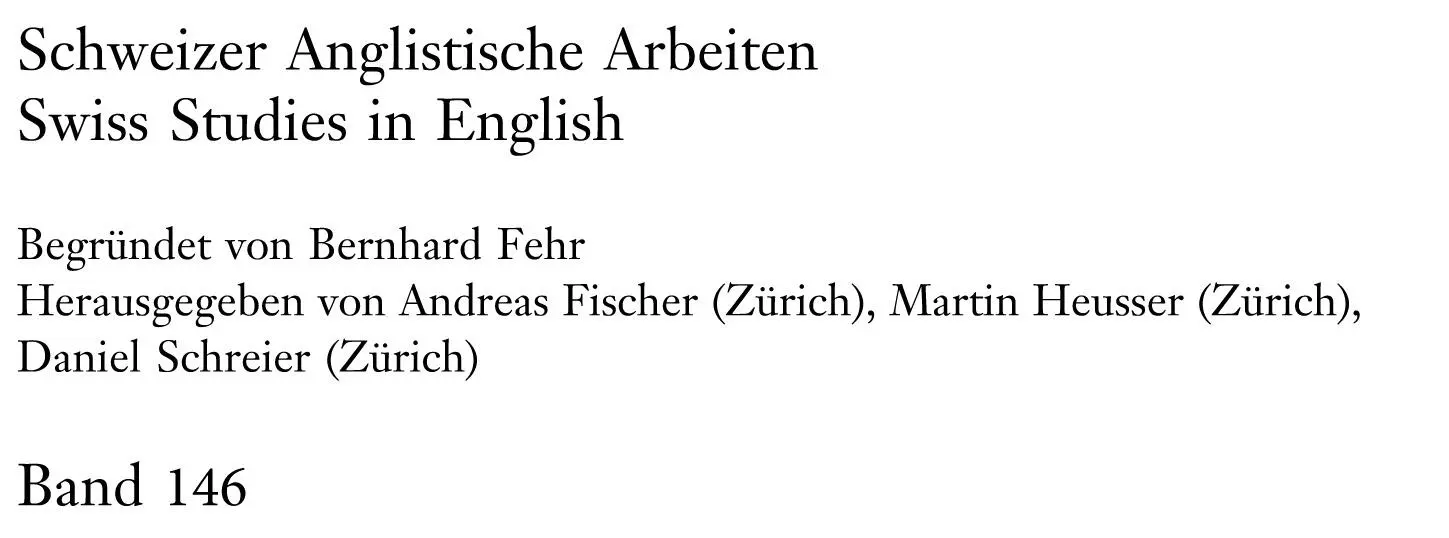
Rahel Rivera Godoy-Benesch
The Production of Lateness
Old Age and Creativity in Contemporary Narrative
Narr Francke Attempto Verlag Tübingen
[bad img format]
Umschlaggestaltung: Martin Heusser, Zürich
Die vorliegende Arbeit wurde von der Philosophischen Fakultät der Universität Zürich im Frühjahrssemester 2018 auf Antrag der Promotionskommission Prof. Dr. Martin Heusser (hauptverantwortliche Betreuungsperson) und Prof. Dr. Harm-Peer Zimmermann als Dissertation angenommen.
Publiziert mit Unterstützung des Schweizerischen Nationalfonds zur Förderung der wissenschaftlichen Forschung.
DOI: https://doi.org/10.2357/EAN
© 2020 · Rahel Rivera Godoy-Benesch
Das Werk ist eine Open Access-Publikation. Es wird unter der Creative Commons Namensnennung – Weitergabe unter gleichen Bedingungen | CC BY-SA 4.0 ( https://creativecommons.org/licenses/by-sa/4.0/) veröffentlicht, welche die Nutzung, Vervielfältigung, Bearbeitung, Verbreitung und Wiedergabe in jeglichem Medium und Format erlaubt, solange Sie die/den ursprünglichen Autor/innen und die Quelle ordentlich nennen, einen Link zur Creative Commons-Lizenz anfügen und angeben, ob Änderungen vorgenommen wurden. Die in diesem Werk enthaltenen Bilder und sonstiges Drittmaterial unterliegen ebenfalls der genannten Creative Commons Lizenz, sofern sich aus der am Material vermerkten Legende nichts anderes ergibt. In diesen Fällen ist für die oben genannten Weiterverwendungen des Materials die Einwilligung des jeweiligen Rechteinhabers einzuholen.
Narr Francke Attempto Verlag GmbH + Co. KG
Dischingerweg 5 · D-72070 Tübingen
Internet: www.narr.de
eMail: info@narr.de
ISBN 978-3-7720-8698-4 (Print)
ISBN 978-3-7720-0114-7 (ePub)
E-Book-Produktion: pagina GmbH, Tübingen
Writing a book-length literary study means spending long hours in solitude. However, as I think about all the friends, colleagues, and acquaintances that were, in one way or another, part of this research project, I must say it turned out to be not so lonely after all. My deep gratitude is due to all those who kept me company.
In the first place, I would like to thank Prof. Dr. Martin Heusser, whose unfailing encouragement and support have accompanied me throughout my years of study and research, and with whom I could always share my thoughts and ideas. Further thanks go to Prof. Dr. Harm-Peer Zimmermann, who provided valuable input in the final stages of the project. I owe much gratitude to all those colleagues and friends who critically commented on parts of this study: Martin Mühlheim, Nicole Frey Büchel, Johannes Riquet, and Simone Heller-Andrist. Shane Walshe agreed to proofread the text on very short notice and did a marvellous job; many thanks go to him, as well. There are others: Dieter Sulzer and the staff of the Pro Senectute Library, who provided guidance in the field of ageing studies; Michelle Dreiding, with whom I shared an office as well as the joys and sorrows of being an assistant and a PhD student, and who has become a dear friend; Madeleine Eberhard, whose enriching conversation, moral support, and steadfast encouragement to think ‘outside the box’ I would not want to have missed; and, finally, my students, who shared my enthusiasm for old age in literature.
I would further like to thank the Swiss National Science Foundation for financing the publication of this book. Kathrin Heyng from Narr Francke Attempto was very helpful during the publication process, for which I am deeply grateful as well. Not last, I would like to express my appreciation to Peter Lang Copyright AG for granting permission to reuse a few passages which I had formerly published in an article.
Life is full of coincidences, and one of them was meeting Linda and Michael Hutcheon during a colloquium in Zurich. They spontaneously invited me to participate in a late-life creativity workshop with Gordon McMullan, David Amigoni, Sam Smiles, Amir Cohen-Shalev, and many other ageing-studies scholars, as well as ageing artists themselves. A further key event was a captivating lecture on Beethoven’s late style by Hans-Joachim Hinrichsen, which I only became aware of thanks to one of my students. Very probably, none of these scholars remembers me but they unknowingly contributed to the way I have come to think about lateness.
Finally, there is my family: my children Daniel, Anna, Isabel, and Celia, who tolerated my long absences with patient understanding. My parents helped out whenever they were needed, cooking countless meals and taking the children for day trips and holidays. I feel blessed to have them in my life.
Speak now before it is too late,
and then hope to go on speaking
until there is nothing more to be said.
Time is running out, after all.
Paul AusterAuster, Paul, Winter Journal
1 Introduction: Approaching Late-Life Creativity in Literature
It is most true, stylus virum arguit , our stile bewraies us, and as Hunters find their game by the trace, so is a mans Genius descried by his workes.
(BurtonBurton, Robert, The Anatomy of Melancholy 13, original italics)
1.1 Old Age, the Age of Style
This study explores artists’ creative practice in old age. However, it does not, as one might expect, investigate the three authors of the texts under scrutiny, John Barth, Karen Blixen, and Joan Didion. Authors are persons of flesh and blood who write and publish works; besides that, they have families and friends, daily household routines, worries and reasons to be joyful. In their families, they may be good or bad or average parents and spouses; to their friends, they may be close confidants or merely good for an occasional chat. They may like going for a walk on a sunny Sunday afternoon, cry over a sentimental movie, or get annoyed at politics. In their works, however, these authors make their appearance as artists . This is not to say that, when authors write, they take on a different, altogether fictional identity, disguising ‘who they really are’ (some may do so, some may not – as some might or might not let their spouses or children or friends know ‘who they really are’). Rather, it is placing emphasis on the fact that writing a text means making a number of decisions, and one of these decisions is how to appear as the originator of the work: what tonetone to adopt, what qualities to foreground or suppress, what stance to take, and certainly not least, what stylestyle to use. In other words, ageing authors, as any other author, choose how to inscribe their creative agency agency in the text, and they do so through their style. Susan SontagSontag, Susan affirms: “Style is the principle of decision in a work of art, the signature of the artist’s will . And as the human will is capable of an indefinite number of stances, there are an indefinite number of possible styles for works of art” (“On Style” 37, italics added). In this sense, therefore, the Latin aphorism stilus virum arguit rings true. Yet, what does a style consist of, and how does it construct the image of the ageing artist? These questions shall be explored here. The present study thus aims to provide a method for reading the textual image of the ageing artist. The significance of this image extends beyond the biography of individual authors. Indeed, it will become clear that it strikes at the very core of the current ‘hot topics’ of ageing studies.
Creativitycreativity and questions of style are serious concerns for ageing authors, arguably more serious ones than for young or middle-agedmiddle age writers. Since the mid-nineteenth century, a scholarly debate has developed, evaluating the stylistic performance of elderly artists with a particularly critical eye (Amigoni and McMullan 377). Due to “a profound shift of critical focus from genregenre to creative artist” in romanticismromanticism, the biography of the artist suddenly became relevant for the assessment of the work, and the critical concept of ‘latenesslateness’ emerged (378). Within this development, the terms ‘late stylelate style’ and ‘old-age styleold-age style,’ which owe their semantic and conceptual origin to German Spätstil and Altersstil , came to refer to the manner in which ageing artists are believed to shape their creative products, often in obvious divergence from their customary style in earlier works (Zanetti 302).
Читать дальше
